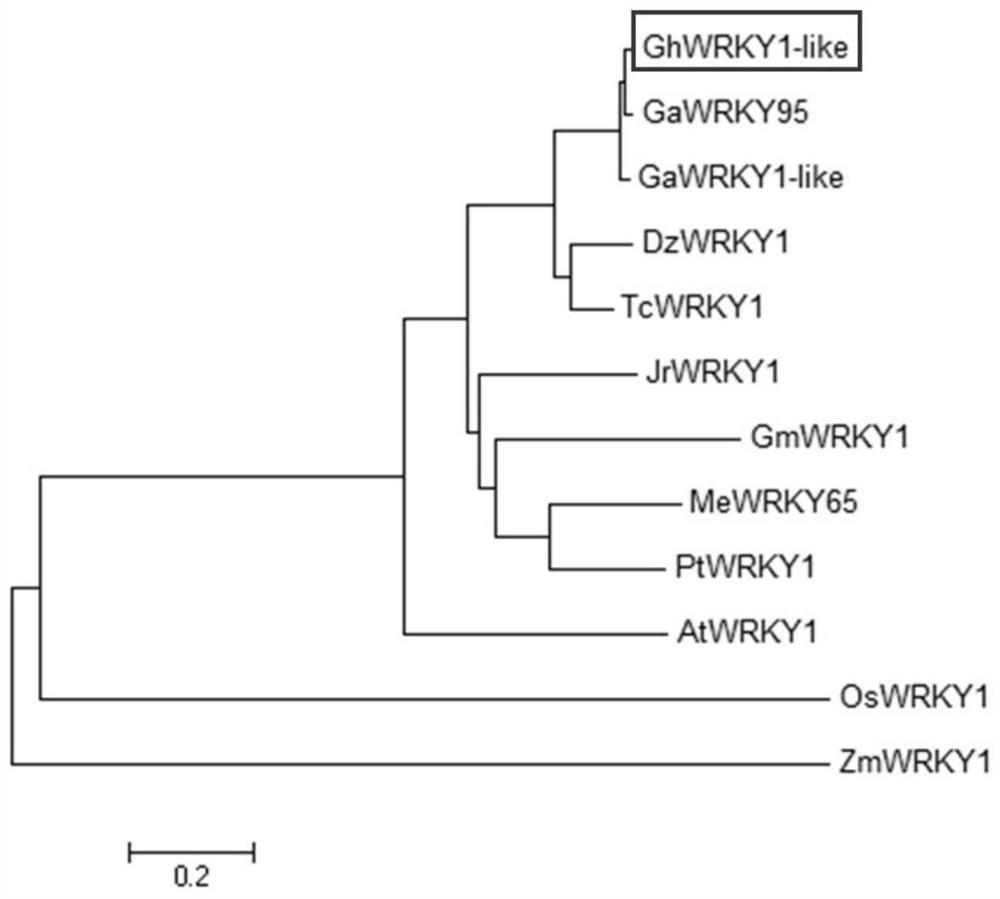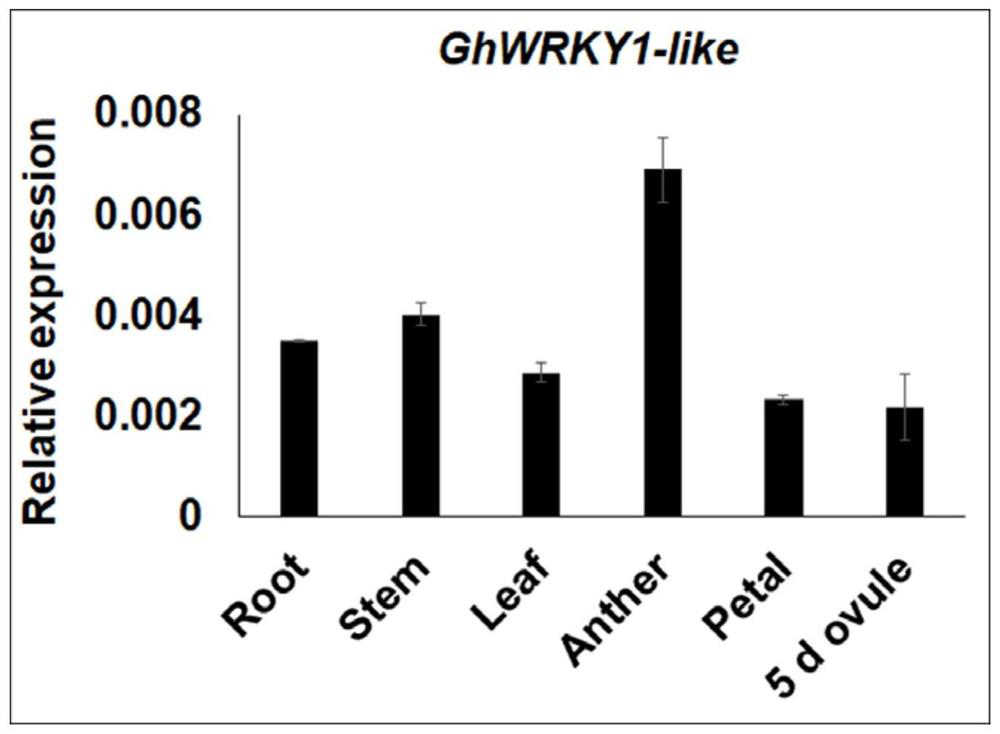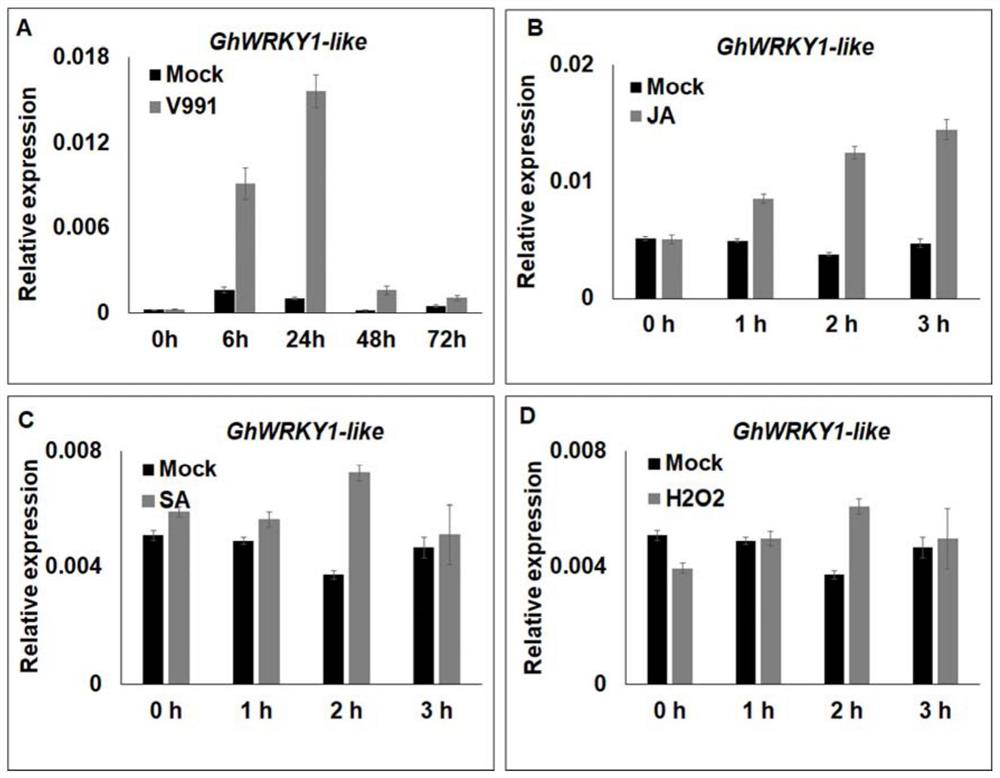Transcription factor GhWRKY1-like gene for regulating verticillium dahliae resistance and drought resistance of cotton and application
A cotton verticillium wilt and transcription factor technology, applied in the fields of application, genetic engineering, plant gene improvement, etc., can solve the problems of narrowness, low selection efficiency, long cycle, etc.
- Summary
- Abstract
- Description
- Claims
- Application Information
AI Technical Summary
Problems solved by technology
Method used
Image
Examples
Embodiment 1
[0039]Example 1: GhWRKY1-like gene isolation and cloning
[0040]1. Obtain the gene sequence
[0041]The applicant’s preliminary work was to analyze the expression profile data of upland cotton YZ1 (upland cotton YZ1 from the Cotton Research Institute of the Chinese Academy of Agricultural Sciences) after inoculation with Verticillium dahliae V991, combined with the VIGS method, and identified a positively regulated cotton verticillium wilt resistance Gene. Sequence alignment in the NCBI database revealed that the gene is highly homologous to the GaWRKY1-like and GaWRKY95 genes in Asian cotton (Gossypium arboretum) and Gossypium hirsutum. At the same time, referring to the latest upland cotton genome annotations, the isolated genes Named as GhWRKY1-like (see the evolutionary tree analysis of the genefigure 1 ).
[0042]Using primers GhWRKY1-like-F (5'ATGGTTCCGTCAGGGGAGTGTG 3') and GhWRKY1-like-R (5'TCAAGGACCTGATATAGGTGCA 3'), the full-length sequence of GhWRKY1-like was cloned using the cDNA...
Embodiment 2
[0047]Example 2: Using VIGS method for gene silencing
[0048]1. Greenhouse nursery
[0049]Select the full-grained cotton line YZ1 seeds, soak them in warm water at 25°C for 2h, and then spread them flat on the soaked gauze, cover them with a layer of moist gauze, and place them in an incubator at 28°C for germination. When the roots of the seeds grow to 1-2cm, they can be transplanted into nutrient soil (volume ratio, nutrient soil: vermiculite=3:1). Gently put the seedling roots into the nutrient soil, and cover with 1-2cm thick nutrient soil, then cover with plastic wrap, and cultivate under light. Set the culture temperature to 28℃ and the light time to 16h. Wait for the seedlings to break the soil. After that, unmask the film. When the cotyledons of the seedlings are fully expanded, the Agrobacterium can be injected and the VIGS test can be performed.
[0050]2. Activation and preservation of Agrobacterium
[0051]2.1 Preparation:
[0052]The Agrobacterium strain is GV3101, prepare a sterile...
Embodiment 3
[0076]Example 3: Agrobacterium-mediated genetic transformation of cotton and Arabidopsis
[0077]Design primers according to the ORF of GhWRKY1-like, and add attB1 and attB2 recombination exchange sites at both ends of the primers, using primers OE-GhWRKY1-like-F (5'GGGGACAAGTTTGTACAAAAAAGCAGGCTCGATGGTTCCGTCAGGGGAGTGTG 3') and RT-GhWRKY1-like-R (5'GGGGACCACTTTGTACAAGAAAGCTGGGTTTCAAGGACCTGATATAGGTGCA 3'), and then use the cDNA of the GhWRKY1-like gene as a template for PCR amplification, and the resulting PCR product is constructed on the pGWB417 vector by the Gateway recombination reaction to obtain an overexpression vector. The overexpression vector contains the nucleotide sequence shown in SEQ ID NO. 2 and the plant expression vector pGWB417. The methods and procedures for genetic transformation of cotton mediated by Agrobacterium GV3101 (Roger et al., A guide to Agrobacterium binary Ti vectors. Trends in plantscience. 2000.5, 1360-1385) refer to the high-efficiency transformation sy...
PUM
 Login to View More
Login to View More Abstract
Description
Claims
Application Information
 Login to View More
Login to View More - R&D
- Intellectual Property
- Life Sciences
- Materials
- Tech Scout
- Unparalleled Data Quality
- Higher Quality Content
- 60% Fewer Hallucinations
Browse by: Latest US Patents, China's latest patents, Technical Efficacy Thesaurus, Application Domain, Technology Topic, Popular Technical Reports.
© 2025 PatSnap. All rights reserved.Legal|Privacy policy|Modern Slavery Act Transparency Statement|Sitemap|About US| Contact US: help@patsnap.com



